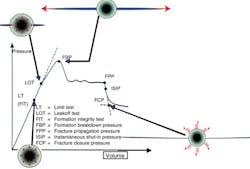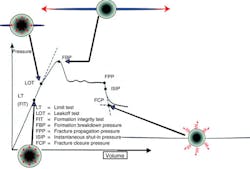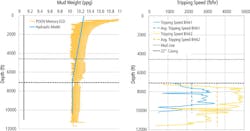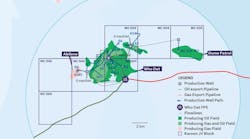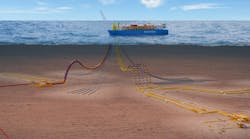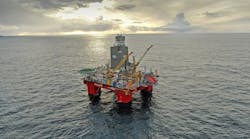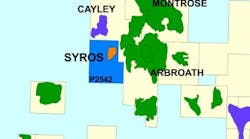Jon Rhodes • Ray Lamborn
Baker Hughes
Drilling safely and efficiently from one section of an offshore well to the next depends on establishing accurate and clearly quantifiable pressure limits related to formation and cement integrity around the casing shoe. This is especially true in deepwater environments where young, fragile formations exhibit low fracture-gradient to pore-pressure-gradient differentials.
Typically, a formation integrity test (FIT) or leak-off test (LOT) is executed immediately after drilling out the casing shoe to establish pressure limits by verifying that the formation and cement around the casing shoe are capable of withstanding the planned hydraulic pressure exerted by the mud column in the section to be drilled. A new, real-time measurement-while-drilling (MWD) service provides a faster, more accurate means of establishing FIT/LOT values using downhole flow-off annular pressure data to establish and work within these crucial maximum allowable pressure limits.
The AccuFIT real-time flow-off pressure data service acquires high-resolution, downhole flow-off annular pressure profile data in real time at the depth of the FIT or LOT, and reliably transmits the data to surface as soon as circulation resumes following the test. The service enables well construction teams to make quick, well-informed pressure control decisions while drilling to ensure well control and maximize efficiency.
Testing integrity, strength
Knowing the maximum hydraulic pressure that a newly entered zone can tolerate is critical to safe, high-performance offshore drilling operations. Exceeding this level in a particular zone may result in mud circulation losses or other hazards, which could lead to costly and potentially dangerous well control scenarios. On the other hand, maximizing tripping speeds to increase well construction efficiency often depends on operating as close as possible to the maximum allowable pressure.
Surface-based formation integrity and leak-off tests are performed to ensure the quality of the cement around the casing shoe; to evaluate the maximum pressure an open-hole section can tolerate; and to estimate the maximum allowable annular pressure for well control purposes. The FIT or LOT is executed after drilling a few feet through the casing shoe and bottoms-up circulation samples indicate that additional formation has been drilled. In each case, the accuracy of the data impacts the ability of the well construction team to make the right decisions to optimize drilling safety and efficiency.
FITs and LOTs, although often juxtaposed or used interchangeably, have two different objectives. A FIT is a pressure test up to a set limit, similar to testing a system to its rated operating pressure. During a FIT, the annular pressure is increased to a prescribed maximum value. It is not intended to fracture the formation, but to confirm that the formation and cement integrity at the casing shoe is strong enough to withstand the drilling-induced pressure expected while drilling the next hole section. However, this does not give any information as to how much additional pressure the formation will withstand and gives no geomechanical information. A LOT is intended to fracture the formation so as to determine the actual formation strength to losses. It is also useful to the geomechanical engineer for calculating the minimum in-situ stress.
Although performed in only a small percentage of cases, LOT results provide vital information for the following:
- Formation fracture pressure gradient - necessary to optimize mud programs and compute kick tolerances.
- Wellbore stability issues and geomechanical applications - used to estimate the minimum horizontal principal stress, which is a critical component for wellbore stability analysis. Geomechanics applications use LOT data for fracture propagation prediction, as well as for calibration and tuning of fracture and closure pressure estimation.
- Pore pressure estimation - a vital measurement in any drilling operation, as the mud hydrostatic pressure must be kept within the safe allowable window to withstand pore or formation pressures, but stay below the fracture gradient. An accurate pore pressure estimation helps reduce non-productive time (NPT) by ensuring that wells are drilled safely and without incidents.
The FIT or LOT is typically carried out using the cementing pump, with the pressure-vs.-time data required for strength interpretation continuously recorded using pressure gauges located at the cementing unit. Other measurements, such as pumping rate and pumped volume, and detailed chronological events are also recorded for quality control purposes. The measured pressures are routinely used in conjunction with the static mud weight to calculate the bottomhole casing shoe strength.
The simplicity of surface-based testing is the main advantage of FIT/LOT; however, the surface-converted downhole pressure generally lacks the required quality and accuracy to maximize either well control or well construction efficiency. The problems lie mainly in the inadequacy of describing the mud column characteristics, which can be complicated by several factors such as mud compressibility, thermal expansion, and barite sag effects on fluid density, particularly in oil- or synthetic-based muds. Gel strength effects can cause pressure transmission delays and pressure losses in the mud column due to the thixotropic behaviors of the mud. Mud temperature influence on induced stresses around the wellbore can result in noticeable changes of the FIT- or LOT-derived equivalent mud weights.
In addition to mud system effects, the data accuracy of surface-based FIT/LOT is dependent upon the accuracy of the cement pumping unit pressure gauge, and the gauge’s location relative to the reference datum. All of these factors negatively impact the quality of the final obtained value. Additional cost and NPT can build up from the significant rig time that is often spent circulating the mud system prior to FIT/LOT in an effort to reduce the known mud system effects.
A real-time view
The newBaker Hughes real-time flow-off pressure data service leverages the annular pressure sensors already present in the existing downhole bottomhole assembly (BHA) to record and transmit high-resolution flow-off pressure time-series data in real time. Using advanced downhole data compression and software automation logic, the service efficiently transmits the pressure profile uphole immediately after normal flow resumes following a connection or FIT/LOT. Downhole intelligence and proprietary data compression reduce rig time for data transmission since data starts at pressure ramp-up and is highly compressed. No downlink is necessary to begin transmitting a pressure profile.
An initial 60-point dataset of the flow-off annular pressure profile event is automatically delivered for immediate interpretation at the well site, or remotely over the Internet or an intranet using a web-enabled remote visualization and analysis service such as the Baker Hughes WellLink RT service. After the initial configuration, subsequent 60-point datasets are available at each connection for continuous trend monitoring. If more detail is required for a particular time interval of interest, it is possible to zoom in to that time interval by sending an additional downlink at any time for 60 data points over that shorter time interval. For ease-of-use and immediate interpretation, each measured pressure point provides actual time, depth, and annular pressure information, including calculated true vertical depth, and equivalent static density information.
Improved, more accurate and reliable downhole measurements help enable critical drilling decisions in real time, leading not only to improved FIT/LOT pressure measurements but also to in-situ equivalent static density (ESD) measurements while tripping to optimize tripping speeds, and during connections to determine if a well is breathing or kicking. A smart flowback monitoring enhancement adjusts alarm criteria as conditions change to enhance safety, eliminate non-representative flowbacks, and detect flowback anomalies.
The data collected and transmitted by the service provides detailed LOT/FIT information to determine the maximum allowable annular pressure for well control purposes and to verify downhole pressure variations for optimizing drilling mud programs. Data from the service can also be used to evaluate swab-and-surge downhole pressure variations for equivalent circulating density (ECD) management, as well as to calibrate and verify the downhole pressure balance for managed pressure drilling (MPD) operations. In MPD operations, the downhole overbalance is verified at every connection by comparing the flow-off ESD to the pre-connection ECD.
Tripping speed increase
A major operator working in thedeepwater Gulf of Mexico needed to drill a deep, deviated well through a challenging formation with a narrow ECD pressure window. The main objective was to safely drill the hole section after the FIT within the known ECD pressure window. An accurate downhole flow-off annular pressure profile was needed in real-time to avoid misinterpretation of the surface-based measurements during the FIT. In addition, the operator wanted to use the flow-off annular pressure data to confirm the hydraulic model and optimize the tripping speed for the BHA in the open hole without swabbing the well.
Before using the downhole-enhanced pressure service at the depth interval of interest, a casing test used the service to obtain the measured pressure data in real time. The results of this test validated that the real-time data provided the expected pressure profile values. After a successful casing test, a FIT was performed and the real-time data from the downhole pressure service was compared to the memory data. This comparison confirmed that the real-time data values were within 1% of the memory data values, deeming these measurements satisfactory for continued use.
While the first BHA run was tripped out, the downhole pressure service recorded data under flow-off conditions and was used to optimize the tripping speed for the second BHA run. The adjusted ESD hydraulic model, calculated by the service provider’s drilling engineering software, indicated an original average tripping speed of 2,250 ft/hr (686 m/hr) for the first BHA run. The tripping speed was increased by 60% to 3,600 ft/hr (1,097 m/hr) for the second BHA run.
The case study presented above is one of several that illustrate how time-series measurements from a new downhole pressure service provide accurate, real-time insights of the annular pressure environment during FIT/LOT events and during connections. These insights help to improve the pressure-related safety factor and operating efficiency of drilling operations.
